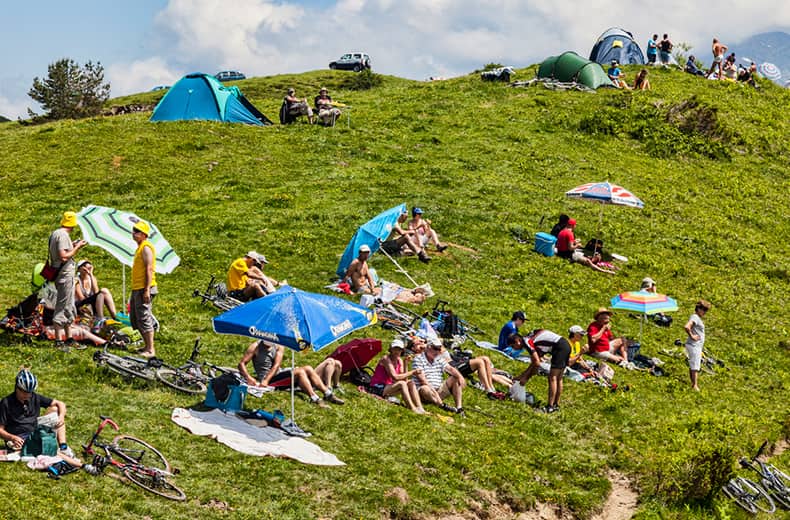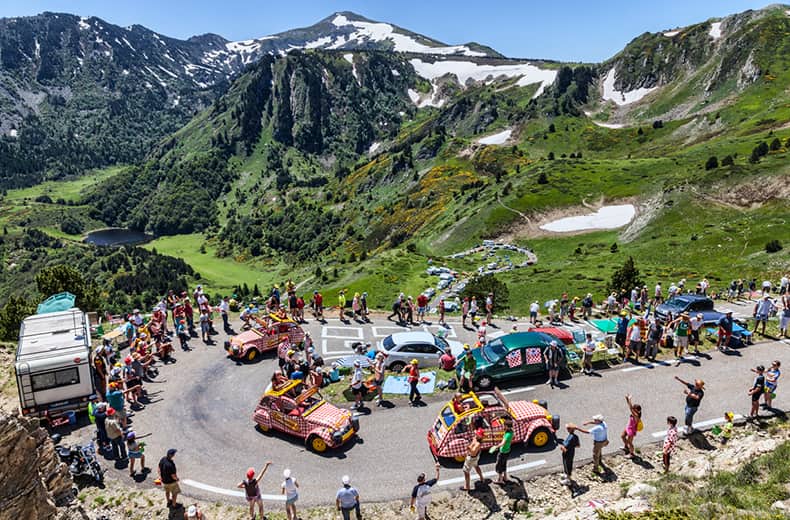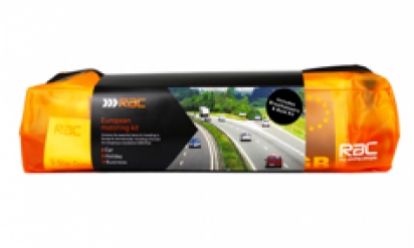As well as taking in some of France’s most stunning scenery, the race is also surprisingly easy to get to from the UK, meaning you could be soaking up the atmosphere sooner than you might think.
To help get your inspiration rolling, here’s our driving in Europe guide to everything you need to know about driving to the Tour de France.
What is the Tour de France?
Put simply, the Tour de France – or Le Tour, as the locals call it – is the world’s greatest cycling competition, held every summer across a series of stages that criss-cross the stunning French countryside.
First held in 1903 as a promotional event for sports newspaper L’Auto, these days the Tour is one of Europe’s most iconic sporting occasions, with 21 day-long stages taking place over the course of 23 days every July.
Cyclists from across the world take part in the Tour, with around 175 riders competing in teams of eight for the coveted winner’s yellow jersey, in stages taking place across a series of physically-challenging terrains.
In recent years, UK riders have been among the Tour’s most successful. This includes Sir Bradley Wiggins, Chris Froome, and Geraint Thomas.
How does the Tour de France work?
The Tour de France features multiple scoring systems across its classifications. The most prestigious is the General Classification (GC), determined by the lowest cumulative time across all stages; the leader wears the yellow jersey.
The Points Classification (green jersey) rewards consistency, with points awarded based on stage finishes and intermediate sprints.
The King of the Mountains (polka dot jersey) is earned by riders who gain points on categorised climbs.
The Young Rider Classification (white jersey) mirrors the GC but is limited to riders under 26.
There’s also a team classification based on combined team times.
When and where is the 2025 Tour de France taking place?
The 2025 Tour de France will take place throughout July, beginning on Saturday, July 5 in Lille Métropole and concluding on Sunday, July 27 with the iconic finish on the Champs-Élysées in Paris.
Spanning 21 stages and covering various terrains across France, the race includes two rest days on Monday, July 14 in Toulouse and Monday, July 21 in Montpellier.
Each stage ranges from 11 km to 212 km, combining flat stages, mountainous climbs, and time trials.
Riders will pass through notable towns, cities, and regions such as Caen, Pau, Courchevel, Mont Ventoux, and La Plagne, challenging their endurance and versatility.
Mountain stages like Peyragudes, Hautacam, and Col de la Loze promise intense competition in the high altitudes.
With stage starts in places like Chinon, Loudenvielle, and Amiens Métropole, and finishes in Châteauroux, Luchon-Superbagnères, and Pontarlier, the race showcases a vast geographic sweep from Normandy to the Pyrenees and the Alps.
The Tour’s structure - with stages nearly every day - demands sustained performance, culminating in the traditional sprint finish in Paris. It’s set to be a dramatic and scenic 2025 edition.
Map of 2025 Tour de France
Here is the offical route for the 2025 Tour de France:

Can I drive to the Tour de France?
Yes, you can. There are plenty of stages of the Tour de France that are within a day’s drive of Calais, meaning it’s surprisingly easy for UK cycling fans to get a taste of the famous competition from the comfort of their own car.
In fact, because the Tour passes through France so quickly and often in rural areas with no public transport links, many fans prefer to drive to the race so they can catch more of the action.
However, whichever stage (or stages) you decide to watch, the first thing you’ll need to do is cross the English Channel — either by taking a ferry from Dover or Portsmouth, or the Eurotunnel from Folkestone.
Once you’re in France, your onward journey will largely depend on which stage you’re wanting to see, with the majority of this year’s stages taking place on the Eastern side of the country.
Wherever you go in France, make sure you’re prepared by researching all the local legal requirements for motoristsbefore you leave home and taking out European Breakdown Cover that meets your needs.
- RAC Temporary Car Insurance - from 1 hour to 30 days
- Did you know we offer car hire excess insurance?
- Bordeaux, France: classic wine country

Instant cover available
• 24/7 rescue at the roadside
• Help to get home if your vehicle can't be fixed
• 5 star Defaqto rated cover

Where’s the best place to watch the Tour de France?
Whether you’re watching on the top of a mountain, in a medieval French village or among the finish-line crowds on the Champs Elysees, there’s nothing quite like soaking up the atmosphere of the Tour de France in person.
The mountain stages in the Alps and the Pyrenees are among the most popular with fans wanting to see riders battle gravity in steep inclines along winding mountain roads, with the dramatic scenery creating an unforgettable spectacle.
The 2025 edition of the Tour has plenty of chances for mountain-top spectating, with multiple stages taking the riders close to or above 1,000 metres in altitude across the mountain ranges.
However, wherever you view the race you’ll be treated to an unforgettable experience as thousands of locals and visitors line the route across the country, cheering on the riders and creating that unmistakable Tour atmosphere.
Can I follow every stage of the Tour de France?

That’s unlikely.
The tour moves through France so quickly that it would be almost as impressive to follow every stage of the Tour with your car as it would to cycle it yourself.
Many fans will instead base themselves in just one area, as the logistics of moving between stages is often too much for even the most dedicated fan, particularly around the harder-to-reach mountain stages.
That said, if you do your research beforehand and choose the right area to base yourself, you’ll be able to watch a few stages quite easily while giving yourself time to check out some of the other surrounding sights and attractions.
What can I expect when driving to see the Tour de France?
As anyone who’s visited the Tour by car will tell you, there are two main things you can expect when taking your car to the race itself: plenty of road closures and plenty of traffic.
Once you’ve decided on your destination, check local websites (or the local tourist office when you arrive) and find out when the peloton is expected to pass by and when local roads will be closed so you’re not caught out on the day.
To stay ahead of the traffic caused, in part, by these closures, many fans will park up near the route early in the morning and then walk or cycle to their viewing point and wait for the riders to come past.
It’s unlikely you’ll be able to get back to your car straight after the riders pass by, as the peloton is followed by around an hour’s worth of support vehicles and the police often don’t let fans cross the road during this time.
Where should I stay when seeing the Tour de France?
There are plenty of options when it comes to visiting the Tour but in order to get what you want it’s always a good idea to book well in advance to avoid disappointment.
Some fans choose to plan their trips around the Tour’s two rest days, allowing more time to soak up the atmosphere.
The 2025 Tour de France features two rest days: the first on Monday, July 14 in Toulouse, and the second on Monday, July 21 in Montpellier. These breaks provide riders with crucial recovery time after intense mountain stages and long distances, helping maintain performance and reduce fatigue during the race. But it also allows fans to enjoy France!
Hotel rooms will often get booked up quickly when the tour locations for the next year are announced in autumn, however there are often cancellations in May and June as the teams themselves change their travel arrangements.
Fans traveling by car will often prefer to camp as this can offer more flexibility than a hotel booking and offers a great way to connect with the beautiful French countryside. Be aware that the more popular camping sites will get full.
Anything else I need to know about driving to the Tour de France?

The most important thing to remember when watching a stage of the Tour is to arrive early because you don’t want road closures and traffic jams putting all your efforts to drive down to the south of France to waste.
Before the riders appear, the ever-popular ‘publicity caravan’ passes through, where sponsorship vehicles give out free gifts to spectators (think chocolate, key rings and the occasional cap), so don’t miss out on grabbing the freebies!
Chances are you’ll be waiting a long time before the action starts, so make sure you’re prepared for a whole day on a roadside verge by taking along plenty of food, drink and sunscreen.
What do I need to remember before driving in France?
Driving on the other side of the Channel is different from driving in the UK, so before grabbing your replica yellow jersey, prepare yourself and your car for France’s driving laws and requirements.
These range from carrying warning triangles and hi-vis vests to Crit’Air clean air stickers, while motorists should also remember that the French drive on the right and have different speed and drink-drive limits to the UK.
The RAC Driving in France kit will help you meet some of these laws, but you should always research the specific requirements for you and your car if driving in another country.
Driving in France Kit from £25.99
Did you know you could be fined up to €530 for not carrying the right kit with you in France?


For more information on what you’ll need to drive to the Tour safely and legally, check out our top tips for driving in France and make sure you don’t get caught out.
And don’t forget, if you want to take in the start of the Tour you’ll be heading to Belgium, so do your research before you leave home and make sure you’re equipped with everything you need for the Belgian roads.
- The best European motoring events
- Driving in the EU in the event of a no-deal Brexit – everything you need to know
- Speed limits in France: the ultimate guide
What do I need to remember before I start my road trip?
Before heading off on any long journey, it’s always important to carry out some essential maintenance checks at home to ensure your car is tip-top condition and you’ll get to your destination – and back – safely.
The RAC encourages motorists to remember the acronym ‘FORCES’ when carrying out car checks: Fuel, Oil, Rubber, Coolant, Electrics, and Screenwash. Check our tips for avoiding a breakdown for more information on FORCES.
You should also remember to take along a few road trip essentials for the journey, including a first aid kit, additional engine oil and water, a mobile phone charger and snacks and games, especially if you’re travelling with children.
Do I need European breakdown cover to drive in France?
Whether you choose to catch the Tour in Belgium or France, the first thing you need to make sure is that you have breakdown insurance that covers the entirety of your trip.
The RAC has some great value European breakdown cover options that offer comprehensive cover if you break down on your way to the Tour de France, offering roadside assistance and a 24/7 English-speaking helpline.

Instant cover available
• 24/7 rescue at the roadside
• Help to get home if your vehicle can't be fixed
• 5 star Defaqto rated cover

What happens if I break down in France?
Depending on the level of your European breakdown cover, the RAC will pay towards any garage labour costs, onward travel expenses and accommodation fees — something to consider if you’ve got a Tour stage to catch.
To find out everything you need to know about breaking down on the continent, and to get the right quote that meets your needs, check out our complete guide to RAC European breakdown cover.









